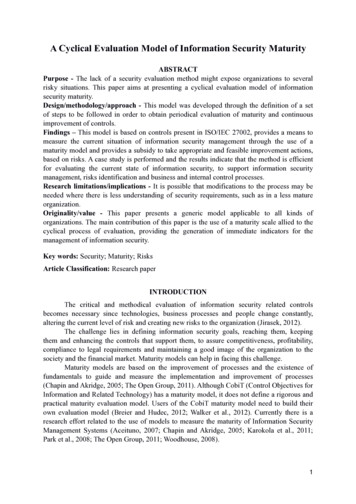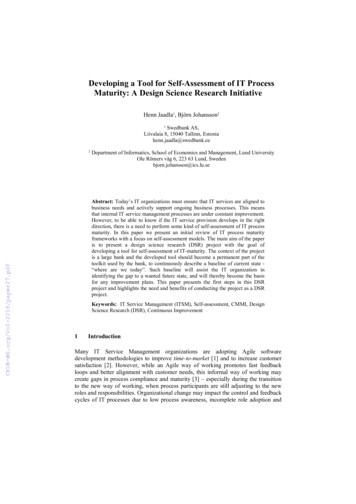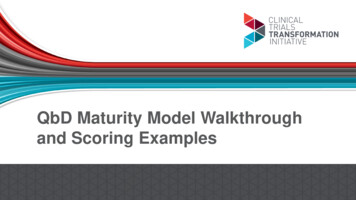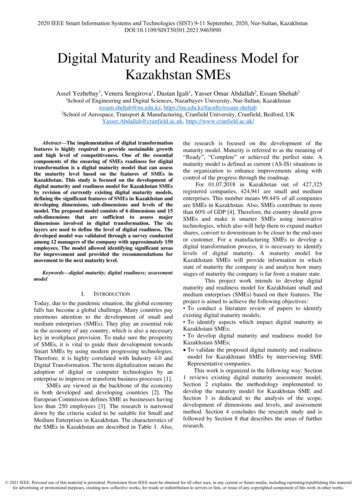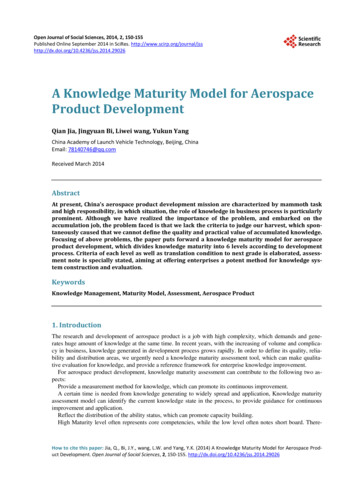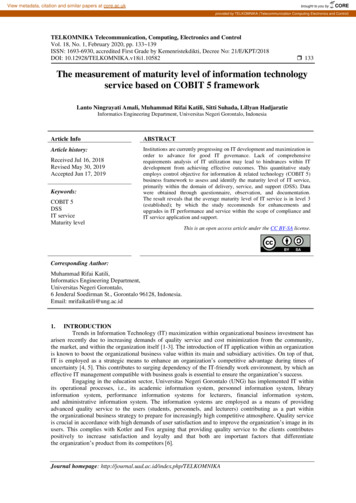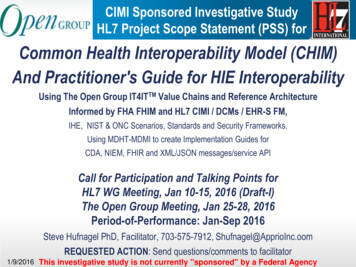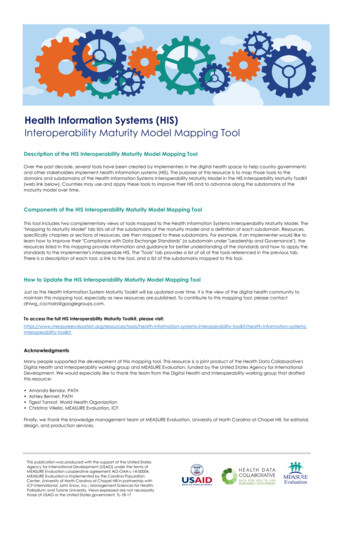
Transcription
Health Information Systems (HIS)Interoperability Maturity Model Mapping ToolDescription of the HIS Interoperability Maturity Model Mapping ToolOver the past decade, several tools have been created by implementers in the digital health space to help country governmentsand other stakeholders implement health information systems (HIS). The purpose of this resource is to map those tools to thedomains and subdomains of the Health Information Systems Interoperability Maturity Model in the HIS Interoperbility Maturity Toolkit(web link below). Countries may use and apply these tools to improve their HIS and to advance along the subdomains of thematurity model over time.Components of the HIS Interoperability Maturity Model Mapping ToolThis tool includes two complementary views of tools mapped to the Health Information Systems Interoperability Maturity Model. The"Mapping to Maturity Model" tab lists all of the subdomains of the maturity model and a definition of each subdomain. Resources,specifically chapters or sections of resources, are then mapped to these subdomains. For example, if an implementer would like tolearn how to improve their "Compliance with Data Exchange Standards" (a subdomain under "Leadership and Governance"), theresources listed in this mapping provide information and guidance for better understanding of the standards and how to apply thestandards to the implementer's interoperable HIS. The "Tools" tab provides a list of all of the tools referenced in the previous tab.There is a description of each tool, a link to the tool, and a list of the subdomains mapped to this tool.How to Update the HIS Interoperability Maturity Model Mapping ToolJust as the Health Information System Maturity Toolkit will be updated over time, it is the view of the digital health community tomaintain this mapping tool, especially as new resources are published. To contribute to this mapping tool, please contactdhiwg cochairs@googlegroups.com.To access the full HIS Interoperability Maturity Toolkit, please -toolkitAcknowledgmentsMany people supported the development of this mapping tool. This resource is a joint product of the Health Data Collaborative'sDigital Health and Interoperability working group and MEASURE Evaluation, funded by the United States Agency for InternationalDevelopment. We would especially like to thank the team from the Digital Health and Interoperability working group that draftedthis resource: Amanda Bendor, PATHAshley Bennet, PATHTigest Tamrat, World Health OrganizationChristina Villella, MEASURE Evaluation, ICFFinally, we thank the knowledge management team at MEASURE Evaluation, University of North Carolina at Chapel Hill, for editorial,design, and production services.This publication was produced with the support of the United StatesAgency for International Development (USAID) under the terms ofMEASURE Evaluation cooperative agreement AID-OAA-L-14-00004.MEASURE Evaluation is implemented by the Carolina PopulationCenter, University of North Carolina at Chapel Hill in partnership withICF International; John Snow, Inc.; Management Sciences for Health;Palladium; and Tulane University. Views expressed are not necessarilythose of USAID or the United States government. TL-18-17
Leadership and governanceDomainSubdomainDefinitionsApplicable Resource ToolsRHIS CurriculumGovernance Structurefor HISThe exercise of technical, political, and administrative authorityto manage the national health information system (HIS) affairs atall levels of a health sector’s hierarchy. It comprises themechanisms, processes, and institutions through which actorsand stakeholders articulate their interests, exercise their legalrights, meet their obligations, and mediate their differences.Description of Applicable Tool Sections to Provide More information onSubdomain TopicModule 7 of the Routine Health Information Systems curriculum focuses on buildingthe enabling policy environment, building a resource pipeline, and creatingchampions.This resource from the Principles for Digital Development is written as a step-by-stepguide to setting up a technical working group (TWG), which can help digitalHow to Set up a Technical Workingdevelopment practitioners realize greater impact by coordinating efforts, systems,Groupand resources to achieve common objectives. This falls under two main principles:"be collaborative" and "understand the existing ecosystem."Link to omnis-ipsam-consequunturenim-ut-aperiam/National eHealth Strategy ToolkitPart 1: Establishing a National eHealth Vision: This section explains how to develop anational eHealth vision that responds to health and development goals. It explainswhy a national approach to eHealth is needed, what a national eHealth plan willhttp://www.itu.int/pub/D-STRneed to achieve, and how it will be done. Part 2: Developing a National eHealthE HEALTH.05-2012Action Plan lays out an eHealth action plan that reflects country priorities and theeHealth context. It structures activities over the medium term while building afoundation for the long term.Planning an Information SystemsProject: A Toolkit for Public HealthManagers (2013)Annex 5 of this toolkit includes a helpful list of "Governance and Design Principles."http://www.path.org/publicationsOther areas of the toolkit include helpful references to governance that may inform/files/TS opt ict toolkit.pdfgovernance structure for HIS.Health Information Exchange:Navigating and Managing aNetwork of Health InformationSystems (2016)https://www.elsevier.com/books/hChapter 4, "Engaging and Sustaining Stakeholders: Toward Governance," outlinesealth-informationprocesses such as data sharing agreements as well as the actors engaged in healthexchange/dixon/978-0-12-803135information exchange.3PRISM RHIS Overview ToolThis assessment tool, which is one of the PRISM tools, provides a way tosystematically document and evaluate the state of routine health . The RHIS Overview Tool includes a checklist of information systems by healthg/resources/tools/healthprogram area and the ability to assess the types of information handled by eachinformation-systems/prismsystem. This tool also assesses the specific ways in which data are collected andtransmitted across the HIS data collection tools, as well as the data flows.
InteroperabilityApproved documents (policies, strategies, and frameworks) thatGuidance Documents guide HIS and digital health/eHealth work in a countryThe electronic toolkit is organized in three sections: Interoperability 101, Standards101, and Adoption & Implementation. The section on Interoperability 101 providesan overview of the importance of OpenSRP and standard definitions for semantic,structural, and foundational interoperability. Users can gain a deeper understandingHIMSS [Healthcare Information andof what standards are and how they are used to facilitate interoperability. Thehttp://www.himss.org/library/interoManagement Systems Society]section on standards also lists the types of standards and their purpose, grouped by perability-standards/toolkitInteroperability ToolkitVocabulary/Terminology Standards, Transport Messaging Standards, SecurityStandards, Content Standards, Service Standards, and Technical Standards. Last,the section on interoperability use cases provides 6 scenarios that rely heavily oninteroperability for improved service delivery and care processes.National eHealth Strategy ToolkitSection 9.6 in Part 1 of the toolkit identifies the eHealth legislation, policy, andhttp://www.itu.int/pub/D-STRcompliance components that are required to support the development andoperation of the national eHealth environment. These compliance components are E HEALTH.05-2012similar to what would need to be considered to strengthen interoperability of HIS.Patient Safety: Achieving a NewStandard for CareChapter 4 provides an overview of health data standards. It has sections on "WhatAre Data Standards" and "Technical Review of Health Care Data Standards" and athorough list of references. This is an ideal resource for someone who is on the lower https://www.ncbi.nlm.nih.gov/books/NBK216088/end of the maturity model and seeks an overview of health data exchangestandards. Compliance is highlighted in the "Implementation of Data Standards"section.Responsible Data ManagementTraining Pack (Oxfam)This interactive training pack helps organziations discuss and plan for responsibledata management. The training pack introduces the concepts of responsible datapractices and guides organizations to discuss how they would handle data ck-620235This resource, from the Principles for Digital Development, is written as a multistepguide to securing private data that are stored/accessed in the cloud, completewith safeguards, outcomes, and common missteps. The guide falls under two mainprinciples: "address privacy & security" and "understand the existing howto-secure-private-datacloud/Adherence to procedures and policies related to system security,Compliance with Datatechnical standards, and data management in order to be ableExchange Standardsto participate in the broader systemData EthicsMoral dimensions of data (including generation, recording,curation, processing, dissemination, sharing, and use), algorithms(including artificial intelligence, artificial agents, machineHow to Secure Private Data Storedlearning, and robots), and corresponding practices (includingand Accessed in the Cloudresponsible innovation, programming, hacking, and professionalcodes), to formulate and support morally good solutions (e.g.,right conduct or right values) in the digital ageThese guidelines help ministry of health policymakers and mHealth programmHealth data security, privacy, and implementers plan to incorporate data security in mHealth programs. Countries can https://www.measureevaluation.orconfidentiality guidelines andg/resources/publications/ms-17use the accompanying checklist to assess which security features their mHealthcompanion checklistprogram has and where they would like to add more functions or policies to protect 125adata in mHealth programs.
HIS InteroperabilityMonitoring andEvaluationBusiness Continuityn resourcesHuman ResourcesPolicyMonitoring and evaluating digitalhealth interventions:A practical guide to conductingresearch and assessment (2016)This handbook is divided across six sections ranging from defining your monitoringand evaluation (M&E) needs to knowing how to report on your data for researchpurposes. Chapter 3 on monitoring digital health deployments and Chapter 5 onassessing data quality are most relevant to work on interoperability. Chapter 3http://www.who.int/reproductivehidentifies key inputs for monitoring the implementation of digital health ing on the incremental requirements from first ensuring basic functionality, thenhealth-interventions/en/checking for stability, and eventually assessing the quality and performance of thedigital system. Chapter 5 provides a worksheet for M&E teams to verify data sourcesand document the quality of the data being generated by digital and paper-basedsystems.Use of message and content standards to facilitate trackinginputs, investments, and processes against desired outcomes andimpactsThe capability of the organization to continue delivery ofproducts or services at acceptable, defined levels following adisruptive incident. It is about devising plans and strategies that Interoperability for Public Healthwill enable you to continue your business operations and enable Agencies: A Self-Assessment Toolyou to recover quickly and effectively from any type ofdisruption, whatever its size or cause.The legal and administrative systems and procedures put inplace to permit a government ministry, agencies, andFinancial Management organizations to conduct their activities so as to ensure correctusage of public funds that meets defined standards of probityand regularityFinancial ResourceMobilizationPRISM Organizational BehavioralAssessment Tool (OBAT)The OBAT is part of "PRISM Tools," one of a series of PRISM documents that can beaccessed from the link given here. The OBAT consists of a self-administeredquestionnaire for facility staff to assess their confidence and capacity to undertaketasks related to managing routine health information system. This questionnaireincludes questions that highlight organizational issues, such as quality of data anduse of information, which are key to internal improvements in HIS.RHIS Rapid Assessment Tool (RAT)All activities involved in securing new and additional resourcesfor an organization. It also involves making better use of, andmaximizing, existing resources. These activities include the raising The mHealth Assessment andof revenue, the management and control of public expenditure Planning for Scale (MAPS) toolkitand financial accounting and reporting, and, in some cases,asset management.A set of principles, guidelines, and norms that an organizationadopts to help manage it employeesPlanning an Information SystemsProject: A Toolkit for Public HealthManagers nents of the self-assessment address the following topics: policies (theprocedures and practices that enable systems to exchange information,capabilities, and services); infrastructure and shared services (the hardware,networking, and staffing that enable system interaction; levels of automation (thelevels at which systems communicate automatically, using information technolog;and data standards (the data formats and technical specifications that enableinformation e RHIS Rapid Assessment Tool has a section on management and governance(page 21), which includes guidance regarding planning, oversight. and t/iris/bitstream/Axis 3 on financial health provides tools including self-assessment questions onhandle/10665/185238/97892415095financial management, financial health scorecards, and related financial guidance 10 eng.pdf;jsessionid C7D0076FB2and resources.8318E8F7863C8E2159A45F?sequence 1This toolkit can help public health managers plan the implementation of informationand communications technology (ICT) in HIS. It draws on lessons learned duringhttps://path.azureedge.net/mediaProject Optimize, a five-year partnership between the World Health Organization/documents/TS opt ict toolkit.pdf(WHO) and PATH for the vaccine supply chain. Step 2 and Annex 2 both provideinformation about building a team for information systems projects.
HumanRHIS Rapid Assessment Tool (RAT)Availability of enough people with characteristics, attributes, andHuman ResourcesCapacity (Skill Set and capabilities to perform a task/set of tasks to achieve clearlyNumbers)defined resultsThe RHIS Rapid Assessment Tool asks questions about RHIS workforce planning andtraining (see section 1.3 of each assessment tab); other human resources questionsare scattered in the assessment, as well. This assessment can be applied at all levelsof the RHIS, from national to subnational to service delivery pidassessment-toolThe Performance of Routine Information Systems Management (PRISM) Toolsincludes an organizational and behavioral assessment tool (OBAT). ThisPerformance of Routine Information questionnaire assesses organizational support and supervision for healthhttps://www.measureevaluation.orSystems Management (PRISM) Tools management information system (HMIS) tasks, staff perceptions of their work on HIS, g/prismand their ability to analyze data. This questionnaire assesses the culture around RHISperformance.Digital Intervention GuideChapter 7 highlights key considerations for adaptive management whenintroducing digital health systems. This chapter focuses on fostering a culture of data Forthcominguse and the behavioral motivations for acting on data.How to Select Digital Tools toSupport Training and CapacityBuildingThis guide from the Principles for Digital Development details the process of selectingappropriate digital tools to support training and capacity building, noting that usinghttps://digitalprinciples.org/resourdigital platforms, such as online learning and mobile learning technologies, cance/howto-select-tools-trainingincrease the efficiency and effectiveness of capacity building and trainingcapacity/activities. This falls under four main principles: "understand the existing ecosystem,""design for scale," "build for sustainability," and "reuse and improve."The mHealth Assessment andPlanning for Scale (MAPS) toolkitDomain 12 in Axis 5 (page 72) details training and support—specifically, theimportance of user training, supervisor training, and user and technical support.Some of the self assessment questions may be useful to determine your gaps for HRdevelopment.Building an Informatics-SavvyHealth DepartmentThe resource says that an informatics-savvy health department is one that has threecore elements: an overall vision and strategy for how it uses information andinformation technology as strategic assets; a skilled workforce; and a well-designedhttps://www.phii.org/infosavvyand effectively used information system. Focusing on these three core elements, theself-assessment tool was developed to enable planning and priority setting toidentify where your agency falls on a continuum.Health Informatics in Low- andMiddle-Income Countries: ShortCourse for Health InformationSystem -countriesshort-course-for-health-informationThis short course is designed to be used as in-service training for digital health staff th-information-systemprofessionalsAn organized activity with clear learning outcomes that aims toHuman Resourceimpart knowledge and skills, shape attitudes, and developCapacity Developmentspecific competencies and capabilities in 665/185238/9789241509510 eng.pdf;jsessionid C7D0076FB28318E8F7863C8E2159A45F?sequence 1
TechnologyGuide to a Team Approach toBuilding Capacity for HealthInformation ManagementEnterprise architecture (EA) is a method and an organizingprinciple that aligns functional business objectives and strategiesNational HIS Enterprisewith an IT strategy and execution plan. When a country uses anArchitectureenterprise architecture to organize its HIS, it is a nationalenterprise architecture.Technical StandardsAn established norm based on a set of requirements,specifications, guidelines, or characteristics that can be usedconsistently to ensure that digital health systems, healthinformation services, and processes are fit for their purposeGuide to help health managers and administrators at subnational levels identify staffhttps://www.measureevaluation.orwith potential; build their capacity in the production, management, and use ofg/resources/publications/wp-17information for effective action planning and other decision making; and mobilize199them to take on HIS responsibilities.The questionnaires featured in the Performance Diagnostic Tool section assess thefunctioning of facility information systems, using categories such as data accuracy,Performance of Routine Informationreporting, and use of information. This may be relevant to enterprise architecture ifSystems Management (PRISM) Toolsusers want to first assess the performance of facility-based systems that would becontributing to the larger smOpenHIEThe web section on architecture provides an overview of registries and reusablecomponents that can facilitate data sharing across external systems. Users can click https://wiki.ohie.org/display/documents/OpenHIE Architectureon the different components (e.g., facility registry) to learn more and join relevantcommunities working in that area.4 Basics to Know about the Role ofFHIR in InteroperabilityArticle that defines the Fast Healthcare Interoperability Resource (FHIR) anddescibes how it works to make systems abilityHL-7/FHIRSection of HL-7 FHIR that defines FHIR. FHIR Specification is a standard forexchanging healthcare information electronically. This page provides an overviewof the standard and serves as a road map for first-time readers of the specificationto help find their way around FHIR th Information Exchange:Navigating and Managing aNetwork of Health InformationSystems (2016)Chapter 8, "Syntactic Interoperability and the Role of Standards," is an excellentreference rmationexchange/dixon/978-0-12-8031353OpenHIE Standards ProfilesList and description of "Integrating the Healthcare Enterprise" (IHE) profiles thatOpenHIE is working toward demonstrating or has demonstrated as supported inreference ments/OpenHIE Standards and ProfilesDemand and Readiness Tool forAssessing Data Sources in HealthInformation Systems (HIS DART)The HIS DART provides an objective appraisal of the alignment of each data sourcewith relevant national and international standards. The HIS DART consists of a set ofhttps://www.measureevaluation.or12 HIS data source modules, with each module containing a mpanied by detailed instructions, question by question, to help theadministrator and respondents to elicit, convey, and record valid information.
Data ManagementHIS SubsystemsPRISM Organizational BehavioralAssessment Tool (OBAT)The OBAT is part of "PRISM Tools," one of a series of PRISM documents that can beaccessed from the link given here. The OBAT evaluates behavioral andorganizational factors that affect routine health information system (RHIS)performance, including questions on data use and management.Demand and Readiness Tool forAssessing Data Sources in HealthInformation Systems (HIS DART)The HIS DART provides an objective appraisal of the alignment of each data sourcewith relevant national and international standards. The HIS DART consists of a set ofhttps://www.measureevaluation.or12 HIS data source modules, with each module containing a mpanied by detailed instructions, question by question, to help theadministrator and respondents to elicit, convey, and record valid information.Master Facility List ResourcePackageThis package is designed to assist countries in the development and managementof their master facility list (MFL). The package contains 10 modules addressing 10specific aspects of MFL implementation. Each module contains a summary ofcontents of the module, checklist of activities that should be completed beforeimplementing the module, and key audiences for the module.http://www.who.int/healthinfo/MFL Resource Package Jan2018.pdf?ua 1This guide provides the steps for developing and implementing a national healthworker registry.https://wiki.ohie.org/display/SUB/Tools and ApplicationsMethods, protocols, and specifications for the collection,storage, transmission, and retrieval of information associated withhealthcare applicationsA system that collects one or more of the data sources in anational HIS. Examples include RHIS, HMIS, civil registration andvital statistics systems (CRVSS), logistics management information OpenHIE Health Worker Registrysystems (LMIS), and human resource information systems (HRIS).Implementation GuideGood Practices for theThis document provides information on best practices of how to set up andImplementation and Managementimplement a Master Patient Index.of a National Master Patient IndexA digital computer and telecommunications network thatsupports and allows digital nodes to share resources. This isachieved through meaningful exchange of data. A LAN andWAN are typically distinguished by the geographical coverageof the network; a LAN usually covers and offers services to arelatively smaller geographical area than a blications/fs-15-147The mHealth Assessment andPlanning for Scale (MAPS) toolkithttp://apps.who.int/iris/bitstream/Axis 5—Operations—includes some references to organizational and programmatic handle/10665/185238/9789241509510 eng.pdf;jsessionid C7D0076FB2measures for supporting implementation, use, and maintenance of the product8318E8F7863C8E2159A45F?sequenthroughout the scaling-up process. This is a high level overview, not in depth.ce 1Hardware and SoftwareMaintenance PolicyExample of a hardware and software maintenance policy. This document includesthe procedures to consider for software and hardware maintenance. A formalpolicy using a format similar to this is an example of the types of operationalprocedures to put in place for your systems.Health Information Exchange:Navigating and Managing aNetwork of Health InformationSystems (2016)The chapter, "ICT Systems," under the "Fundamental Components of HIE" section,includes information related to ICT specifically. The chapter, "Supporting HIEInfrastructure," also includes useful information on interoperability.Operations andA set of procedures to ensure high up time for computerMaintenance (forhardware, software and network resourcesComputer Technology)CommunicationNetwork: Local AreaNetwork (LAN) andWide Area Network(WAN) -8031353
HardwareAn assembly of tangible physical parts of a system of computers,including servers and virtual private networks (VPN), that provideservices to a user in the health information ecosystem.Information and CommunicationTechnologies for Women’s andChildren’s Health: A PlanningWorkbookThemes 5 and 7 relate to the infrastructural and technological capacity of ministrieshttp://www.who.int/pmnch/knowlto absorb digital health implementations. These sections include questionaires toedge/publications/ict mhealth.pdassess the selection of hardware and devices that can be supported by the localfICT infrastructure.MOTECH Lessons LearnedThe section on handsets, starting on page 15, provides important operationalconsiderations regarding the provision of hardware, including mechanisms forpreventing loss/misuse of ech-lessons-learned
Tool4 Basics to Know about the Role ofFHIR in InteroperabilityDescriptionBrief online article about FHIR.LinkApplicable Sections to main: Technology; cal Standardsfhir-in-interoperabilityThe resource articulates that informatics-savvy health department as one which has threecore elements: an overall vision and strategy for how it uses information and informationBuilding an Informatics-Savvy Health technology as strategic assets; a skilled workforce; and well-designed and effectively usedhttps://www.phii.org/infosavvyinformation systems. By focusing on these three core elements, the self-assessment tool wasDepartmentdeveloped to enable planning and priority setting to identify where your agency falls on acontinuum.Domain: Human Resources; Subdomain:Human Resource CapacityDevelopmentDemand and Readiness Tool forAssessing Data Sources in HealthInformation Systems (HIS DART)Domain: Technology; Subdomain:The HIS DART provides an objective appraisal of the alignment of each data source withTechnical Standardsrelevant national and international standards. The HIS DART consists of a set of 12 HIS datahttps://www.measureevaluation.orgsource modules, with each module containing a questionnaire accompanied by ns, question by question, to help the administrator and respondents to elicit,Domain: Technology; Subdomain: Dataconvey, and record valid information.ManagementDigital Intervention GuideChapter 7 highlights key considerations for adaptive management when introducingdigital health systems. This chapter focuses on fostering a culture of data use and thebehavioral motivations for acting on data.forthcomingFHIR Release 3 (STU)Online resource from HL7 about FHIR.https://www.hl7.org/fhir/overview.ht Domain: Technology; Subdomain:mlTechnical StandardsGood Practices for theImplementation and Managementof a National Master Patient IndexThis document provides information on best practices of how to setup and implement anMaster Patient Index.https://www.measureevaluation.org Domain: Technology; Subdomain: e to a Team Approach toBuilding Capacity for HealthInformation ManagementThis guide to help health managers and administrators at subnational levels identify staffwith potential; build their capacity in the production, management, and use of informationfor effective action plan
This tool includes two complementary views of tools mapped to the Health Information Systems Interoperability Maturity Model. The "Mapping to Maturity Model" tab lists all of the subdomains of the maturity model and a definition of each subdomain. Resources, specifically chapters or sections of resources, are then mapped to these subdomains.

